There are a lot of reasons to get a garage. Garages protect your car from the elements while also keeping it safe from thieves. They provide your home with extra storage or room for recreational vehicles. They make it easier to unload groceries after a long day at work. And they increase the value of your home.
No wonder then that the National Association of Home Builders reports that 61.9% of homes built in 2014 included a two-car garage. Another 23.5% were built with a three-car garage or larger, a significant increase over the 19% found in new homes built ten years earlier.

However, if you are looking to either remodel an existing garage or build a brand new garage as an addition to your home, you likely have a few questions. What is a standard garage size? How about garage door width? What is the size of a single car garage? Is there a standard double car garage door size?
Because of the wide variety of garage sizes, answering these questions is an essential first step for any proposed garage addition or remodel. That’s why we put together this introduction to both custom and standard garage door sizes.
Whether you are interested in figuring out standard single car garage door dimensions, commercial garage sizes or how much space you need for a triple car garage, we hope that this guide with take the mystery out of all of your garage size questions. Because in the end, we want you to have the perfect garage door size for your home or business.
Contact UsTable of Contents
- Standard Garage Door Sizes
- Planning Your Garage Door
- Further Thoughts on Vehicle Sizes
- Standard Car Size Estimates
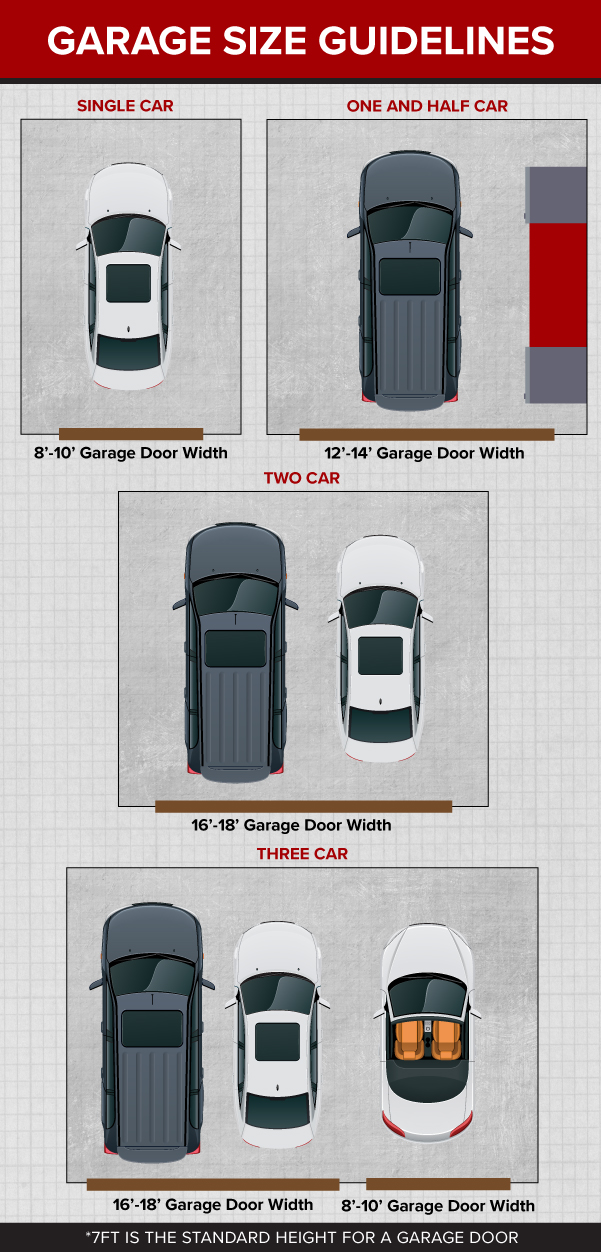
Standard Garage Door Sizes
While the numbers of possible garage door sizes are practically limitless, there are standard dimensions for garage doors that are most common in new garage installations. By incorporating a garage door with a standard size, you can avoid the higher costs of door size customizations. With that in mind, here are the most common garage door sizes.
Single Car and 1.5 Garage Door Size: There isn’t just one standard single car garage door size, there are 3. Doors are either 10 x 7, 9 x 7 or 8 x 7 in size. However, keep in mind that an 8 x 7 size door is a tight fit for SUVs, trucks and vans. If you are looking to build a new addition with typical single-car garage dimensions, you will most likely be incorporating either a 10 x 7 or 9 x 7 size door. The 8 x 7 door size is typically only installed when the dimensions of a preexisting a single-car garage make a larger door impossible.
Furthermore, keep in mind that single-car garage doors make parking an RV or an oversized truck nearly impossible. Similarly, even a 10 x 7 door combined with the size of a single car garage will limit the amount of available storage, especially if you have a full-sized car.
In addition, some homeowners prefer a slightly larger 1.5 car garage to accommodate extra storage or recreational vehicles, especially if they don’t have room for a full two-car garage.
Double Car Garage Door Size: Like single car garage size doors, there are a number of standard size doors classified as doubles. The largest can measure 14 x 7, while 12 x 7 size doors are also available.
While these doors are called double doors since they can accommodate multiple cars, many people with large cars prefer to use a double-sized door even if they only intend to park one car in the garage. The same is true for those who are looking to use half of their garage for parking and the other half for storage.
Triple Car Garage Door Size: A full triple car garage door is rare. Most residential three-car garage door owners instead opt for either one double door and one single or three single doors. That way you can keep the rest of your garage closed when parking one car.
However, if you are committed to having one triple-wide door, there are ways to customize your door to meet your needs. This is an especially good option if you have an especially large-sized vehicle that you want to park in your garage.
RV Size Garage Doors: You may have noticed that while the width of standard size garage doors change, their height remains the same: 7 feet. However, those with extra tall RVs often require more headroom than a 7-foot door can provide.
There are a number of oversized standard doors that are made especially for RV owners. The most common door installed by RV owners is 16 x 8. However, keep in mind that these types of doors usually require further architectural accommodation. You may have a hard time retrofitting an existing garage that doesn’t have the required clearance.
Commercial Size Garage Doors: Finally, commercial-sized garage doors come in a very different standard size. That’s because these doors are designed to accommodate everything from moving equipment to a backed-in semi truck.
The typical size for a commercial-style door is 32 x 24. However, you must also take into account the types of trucks that will be regularly docking at your commercial site. While a typical semi-truck will easily match a 32 x 24 size door, there are a number of more specialized commercial trucks that may require another dimension.
If you anticipate typically accommodating standard-sized trucks, but know that you may occasionally need to receive deliveries from a very different sized truck, you should consider installing multiple doors on your dock, with one door being specially designated for the uncommon sized vehicle.
Planning Your Garage Door
Now that we’ve discussed many of the standard sizes, there are several other things that you should consider if you are planning to build a new garage with a new door installation.
Know What You Need: While a good architect or garage door salesperson would never pressure you into purchasing an ill-fitting garage door, know that most garages use a standard size. Because of this, if you don’t make your needs clear from the onset, you may find that you are dissatisfied with the fit of your car or the storage space within your garage.
The most common requirement is a larger size. Today’s pickup trucks are bigger than ever. Even standard-sized SUVs and full-size luxury cars may be a tight fit in the standard 9 x 7 door.
Furthermore, you want to anticipate reasonable future needs. If you do not yet own an RV, but you think you could very likely own one in the near future, you should consider installing a garage door that can accommodate a taller vehicle. If you install a new standard height door and then realize a year or two later that you also want to add an RV to your fleet, you will likely be stuck parking the RV in the driveway, as raising the height of the door could very well be impossible without tearing down the whole garage.
Think About The Whole Garage: You also don’t want to get caught up thinking only about the size of the door. One of the best features of a garage is its versatility. It is a great place for parking your car but it is also a great place to store things.
Consider this scenario: You only own one car, so you assume that you will only need a single car garage. However, you quickly start to fill your garage with other items, such as sports equipment, lawn mowers and other tools. Before too long, you have to choose whether to keep your stuff where it is or make space for your car.
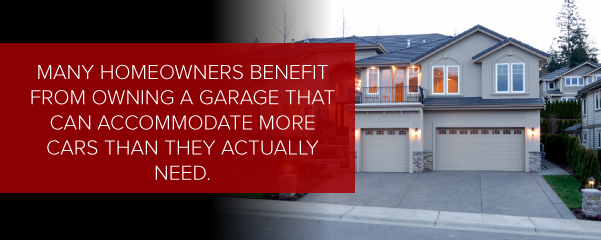
Many homeowners benefit from owning a garage that can accommodate more cars than they actually need. If they are a two car family, they opt for a three car garage. That way, two spots can be used to park cars and the other spot can be used for storage.
This is especially convenient if you plan on storing lawn and gardening equipment in your garage, as most people do. By having a dedicated car port for you gardening equipment, you will find that you can easily access your tools when you need them rather than removing a car just to pull out your mower. Or worse, scratching your car because you are trying to squeeze a weed whacker through a tight spot.
It’s Easier to Make a Door Smaller Than Bigger: Even with the best prior planning, you may find that the size of your door doesn’t match your needs. Reducing the size of your garage door is much easier than expanding it. Structurally, this only requires building in a portion of your garage door opening and then installing the smaller door within the smaller space.
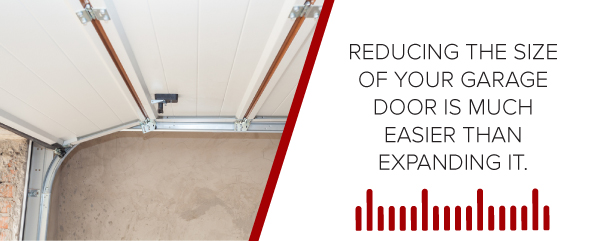
Unfortunately, very few homeowners actually want to have their garage door made smaller. Instead, they come to realize that their small door no longer meets their needs.
The problem is that installing a larger garage door isn’t as simple as cutting a larger hole. Garage doors require at least a foot of clearance above the top of the door. That’s because when the door is opened, it needs space against the garage ceiling to rest or else the inside of your garage will actually be smaller than the opening of the door.
Because of the way garages are designed, they usually aren’t built with space to grow, meaning they only have just as much clearance as is required to fit the original door.
That means if you do want to raise the height of your door, you may need to raise the roofline of your entire garage. If your garage isn’t detached and is built within the main structure of your house, you will likely find raising the roofline to be either impossible or so cost-prohibitive that it isn’t worth the investment.
If your garage is detached, you may find that raising the roofline is worth it, but regardless, it will be far more expensive than getting the taller door installed initially.
Further Thoughts on Vehicle Sizes
While you may agree that planning ahead is good, and making a smart investment is the best path for building your new garage, you may also still be unsure about the best size garage for the specific vehicle you own. To help you get a better sense of how your car may fit in your garage, we thought we would break down exactly how to measure your car and compare that with what other dimensions you’ll need.
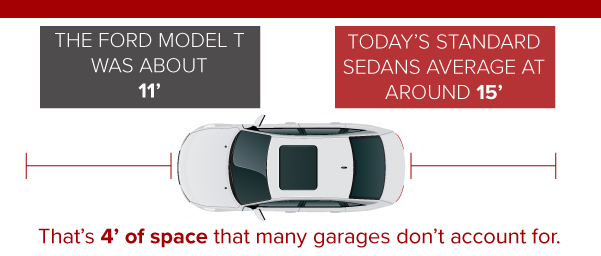
According to Houzz, garage sizes haven’t changed, even as car sizes have. To put this in perspective, they note that the Ford Model T was 134 inches long, about 11 feet. Today’s standard sedans average at around 15 feet. That’s 4 feet of space that many garages don’t account for.
What guidelines should you then use when planning the dimensions of a new garage?
Space Between Cars: Obviously, this only applies to garages that are going to accommodate more than one car. However, keep in mind that with a single car garage, you will have limited space for storage or future growth in your household.
It is recommended that you leave at least 36 inches of space between your cars in order to prevent accidentally denting your other car with your door.
Consider Storage Furniture: If you are planning on using your garage for storage, at least in some capacity, you should also make sure to build storage furniture into your measurements.
Luckily, storage cabinetry for garages is very similar to kitchen cabinetry. Most garage cabinet systems are 24 inches deep, but if you have to work with tighter spaces, you can also find slimmer cabinets that are 12 or 18 inches deep as well.
Consult Your Car Manufacturer: One of the nice things about being a car owner today is that you can skip pulling out a tape measure if you want to know the exact length and width of your car. Just go onto the manufacturer website for your car and pick your exact model and year and you can easily find your vehicle’s specifications, assuming you haven’t made any drastic aftermarket modifications. Don’t forget to include the mirrors in the width measurement!
Once you have the width and length of your car along with the depth of any storage furniture you plan installing while making sure to include the minimum space between cars, you will have the data you need to make an informed garage design decision.
Consult Local Building Codes: While you may have an ideal garage size in mind, you also need to make sure that any future construction is in compliance with local building codes. Historic districts may have a limit on the size of your garage while other zoning codes have specifications on the minimum size allowed.
Don’t Forget the Lawnmower: While some homeowners opt for a storage shed for their lawnmower, many keep theirs in the garage. Depending on the size of lawnmower that you use, you may have a very hard time getting it out of your garage unless you’ve built in an appropriately sized space for it.
This is especially true if you own a riding lawnmower. If you keep your lawnmower against one of the garage walls, getting it out will either require moving your car first or having enough clearance beside your car to move the lawnmower out with the car still parked.
If you are choosing to use one of your available car ports for storage, this is a great place to keep your lawnmower. Even the largest lawnmower designed for home use is much smaller than a car, so you will have plenty of space for storage in front of where you park your mower.
Standard Car Size Estimates
Although you should use the specifications of your car if possible, if you are building a garage that you want to be accommodating for potential future purchases, it may be helpful to have a sense of the average size of cars of various classes.
Vans and SUVs:
These are the largest cars in the typical family fleet. They are usually 6 to 7 feet wide, 16 to 19 feet long and 5 to 6 feet high. Keep this in mind if you are considering the smaller 8 x 7 foot door. A 7 foot wide van will be a very tight fit in one of these smaller entries.
Standard and Luxury Sedans:
While they are not as large as SUVs, these large sedans can still be sizable. Furthermore, while scraping the side of any car is frustrating, scratching a luxury car can be especially costly. These sedans average 6 to 6 1/2 feet wide, 16 to 18 feet long and 4 1/2 to 5 feet high.
Sports and Compact Cars:
At the end of the day, smaller cars are easier to park in a garage of any size. They are usually between 5 to 6 feet wide, 14 to 16 feet long and 4 to 5 feet high.
Local Garage Door Installation and Design Planning
If you are in the Greater Spokane Washington or Northern Idaho areas, there is no better place to turn for garage door repair and installation than Continental Door Company.
We offer a wide selection of residential doors in every standard size, as well as commercial and industrial garage doors. So regardless of your design tastes or proposed configuration, you are sure to find what you need with us. Furthermore, we are experienced with custom door fabrication, meaning that even if you have specific needs that cannot be met with factory standard doors, we can take care of you.
Regardless of what design you choose, whether you are opting for a factory standard door or a custom made one, you can trust in our quality. We know how important our work is for the people of Spokane, whether they are business or homeowners.
Whether you are looking to build a whole new garage or simply want to give your existing garage a facelift, contact us for a free estimate. Even if you are still trying to figure out exactly what your garage plans are, our professional staff are able to assist you with any measurements or planning, helping to make your job easier.
Request An EstimateView Our Guide to Understanding Garage Door Sizes
Transcript:
“Hi, Derek with Continental Door here, and today I’m going to go over door sizes. So you’ve got a one car garage — a single car garage — which is over here, and that’s defined off the width. It can be anywhere from as small as seven, eight, nine, or ten feet. This one over here is a ten wide, that’s a single car, and then a car and a half garage is something that is in between there. It’s not quite a two car, like over here — an eighteen by eight, it’s a twelve or a fourteen or something in between where it’s kind of a car and a half, it’s not quite a one car or a two car. A two car garage is anything greater than sixteen or eighteen [feet] that you can park two cars in. Thank you for watching! For any questions, please feel free to call us or check us out online.”
Request Information About Garage Doors
Updated: 05/22/2019

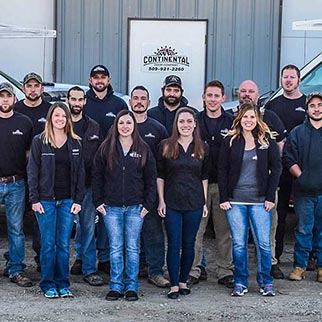
Since Side Hinged Doors are conventionally installed between the opening, the most important dimensions are the of the overall door panel and frame size.